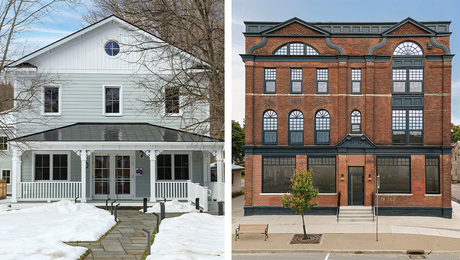Next month I’ll begin finishing the exposed sections of my ICF (Quadlock) basement walls with Robinson Thinbrick, a clay product 5/8″ thick. Walls hidden by decks will be covered with stucco. I’m installing the expanded metal lath now.
I’m getting varied advice on how to install the brick. The manufacturer recommends a Type N mortar scratch coat followed by buttering the bricks during installation after the scratch coat cures.
One of my local masons recommends using acrylic instead of water in a Type S mortar scratchcoat followed by poly-modified Thinset mixed with more acrylic to install the bricks. The thinking here is that freezing is less likely to pop a brick loose during our wet winters.
With either method I plan to add a bonding agent to my scratchcoat and grout the joints after curing. There is little local experience with this product, but good results have been achieved with cultured stone and both Type N and Type S mortar.
Can anyone add their experience to my decision process?
Thanks
“When we build, let us think that we build forever. Let it not be for present delight nor for present use alone. Let it be such work as our descendants will thank us for; and let us think…that a time is to come when those (heirlooms) will be held sacred because our hands have touched them, and that men will say, as they look upon the labor and wrought substance of them, ‘See! This our father did for us.’ “ –John Ruskin.




















Replies
Bob, I think either mortar will work fine. I'd probably follow your local mason's advice.
I used a thinbrick product a year ago; I installed cement board and used a latex-modified thinset to adhere the thinbricks. I back-buttered each brick, and pointed up with lime mortar (for an appropriate 1830s look).
This was for a "replica" chimney. It's made it through one Buffalo winter so far, and still looks good.
I've posted this photo before, but it shows the end result (attached below). Second photo is a more recent view.
Allen
Allen, there's a decent chance I will be doing this same thing for a water heater vent. How did you conceal the round pipe (if there was one)?
Looks like you flashed it like a regular chimney, is that correct? Does your metal only penetrate the verticle for the distance of the thin brick?
How did you achieve the extra thickness on the fancy rows up top?
Thanks.
Don K.
EJG Homes Renovations - New Construction - Rentals
Don, the double-walled stainless steel terminates a couple inches short of the top of the chimney. The chimney is capped with sheet metal. The top row of bricks are full, antique bricks, some of which I've cut down for venting. The chimney vents an oil furnace.
It's definitely not to manufacturer's specs, but I wanted to make it look as authentic as possible. The biggest problem I've had is that the high water content in the furnace exhaust condenses on the underside of the cap, and drips down into the attic. I fabricated a catch basin to deal with it, but that solution is less than ideal.
I'll be doing another "faux chimney" next year, so I'm open to suggestions!
I'm thinking maybe I should terminate the SS pipe a bit lower, but am worried about losing draft. The draft now is amost too strong, so that's probably not an issue.
The flashing is sheet lead, and it only penetrates the half-inch thickness of the thinbrick. There is redundant flashing that extends up behind the cement board.
The extra thickness was achieved by using actual antique bricks sawed to a one-inch thickness. Actually, about half the "thin bricks" on the face of the chimney are true bricks I sawed to half-inch thickness. I was less than satisfied with the Robinson ThinBrick product (see next post), so I incorporated the real bricks on the front.
When I first read your question, I thought you were asking about the drain vent. Unfortunately, it pokes through the roof in a most inauthentic manner. But I painted it flat black to minimize the ugliness. (I've since read here on BT that those rubber flashing things aren't good ... oh well, live and learn).
I've attached a couple photos. First one shows the chimney cap; second shows the drain vent (and eastern white cedar roof).
Allen
Allen
I didnt realize that your chimney wasnt "real"
Did the house originally have a brick chimney and if so was it to far gone to save?
I have to do something with my chimney, was considering just tearing it out, dont need it because I am installing a new furnace and dont need the vent.
I hate to give up the look of the chimney protruding out the middle of the house, I have mixed feelings as to what to do.
I could save enough brick by tearing the old one out, wouldnt need to buy/find anything to match.
Obviously the weight of the new chimney would be easy to deal with so that would be a plus.
I think you've givin me something to think about.
Doug
Doug, the original chimney was completely dismantled by a previous owner, probably in the late 1930s (I actually talked to him about it; he said it was a "big" job! He was in his 90s when he died about five years ago).
My chimney matches the exact footprint of the original; although I think mine might be a course shorter ... the old photo I have is not very clear. The original was built from the attic "floor" up and through the roof. A stove pipe connected to it in the attic.
I'll be replicating another "lost" chimney next year. And like the original, I'll be venting a woodstove through it. The dimensions (based on the cutout in the roof) are adequate to get minimum clearance between the frame of a fake chimney and the stainless stovepipe.
View Image
Allen
Thanks Allen, I saw your chimney when I searched the forum some time ago for Thinbrick posts.
Most impressive....I have ordered enough brick to do my chimney that way too, although I wish I had a big enough machine to construct it on the ground and lift it in place. I plan on using a 2X6 frame and cement board to construct the body and corbels. Did you thinset the brick in place to the cement board without a scratch coat?
I take delivery on 300SF of thinbrick next week, and will begin as soon as I get the last wall poured and damproofed. I guess I'll spring for the acrylic, as it'll only add a couple hundred bucks to a $2800 project.
I'll post pics when I get started.“When we build, let us think that we build forever. Let it not be for present delight nor for present use alone. Let it be such work as our descendants will thank us for; and let us think...that a time is to come when those (heirlooms) will be held sacred because our hands have touched them, and that men will say, as they look upon the labor and wrought substance of them, ‘See! This our father did for us.’ “ --John Ruskin.
Bob,
I also framed my chimney with 2 x 6 that extend all the way through the roof to the second floor ceiling joists. I also used diagonal bracing ... probably overkill, but I wanted to absolutely minimize any flexing.
Yes, I used latex-modified thinset with no scratch coat on the cement board.
In your BT search, you may have found my complaints about the Robinson Thinbrick product. I ordered it sight unseen, and was very disappointed to find it to be a cement-based material, rather than true clay.
The Website gives the impression that it's clay, but actually it says, "For the look of real clay brick ..."
I should have gotten a sample first, but was under the gun to complete the project before winter. The color wasn't as expected, either, so I created several variations of red and orange-red wash (thinned oil-base paint) and stained the Thinbricks before installing.
For the front of the chimney, I sawed real antique bricks to a half-inch thickness (but used the Robinson product for the corners). I used a cheapo tile saw to cut the antique brick ($40 from HD). In the end, the chimney is much sloppier than I had wanted, but it blends in fairly well with the overall appearance of the house.
Looking forward to your photos!
Allen
Nice! Am I the only person left on the planet who is deeply disturbed by the vinyl-clap covered chimneys I see all around?
NO YOUR NOT!
Doug